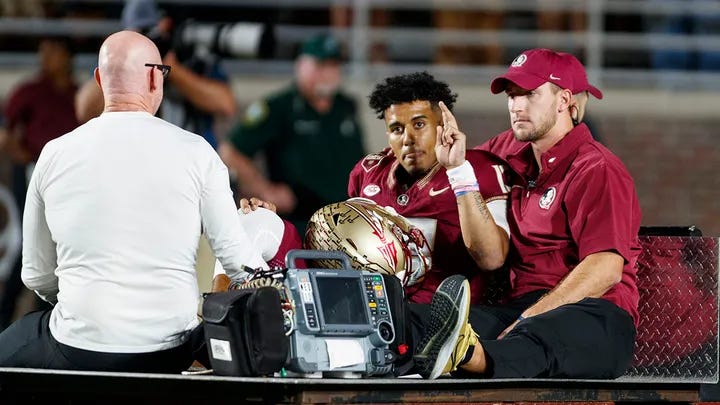Florida State’s exclusion from the College Football Playoff didn’t just break precedent. It showed what’s to come
The expansion to a 12-team playoff next season looks more and more like a way for the SEC and Big Ten to consolidate their already immense power
Unbeknownst to anyone who was watching the game on a mid-November night, the fate of this year’s College Football Playoff and the 2023 college football season as a whole was decided with 1:57 left in the first quarter of a game in which Florida State paid North Alabama $400,000 for a lopsided win.
On a 1st-and-10 play, Florida State quarterback Jordan Travis scampered for a 16-yard gain, but before the play ended, his leg was rolled on and twisted by the defensive player who tackled him, resulting in one of those grotesque injuries where you know the severity of it simply by looking at its end result. Travis broke his leg and was out for the rest of the season.
Ten days later, and after a Travis-less Seminoles team wrapped up an undefeated regular season, what had been an uplifting story of a breakthrough season for a dormant powerhouse took on a more ominous tone.
That night, after the second-to-last batch of rankings was revealed, College Football Playoff executive director Bill Hancock said that "most deserving is not anything in the committee's lexicon” when discussing the playoff selection committee’s rationale for choosing the four-team field.
“They are there to rank the best teams in order, and that's what they do, so just keep that in mind,” Hancock said.
Florida State was No. 4 in that night’s rankings, meaning that, theoretically, all it had to do was beat Louisville in the ACC championship game and it was in. Of course, it wouldn’t be that simple.
The Seminoles won that game, this time with a third-string quarterback, but the following day, they were excluded from the playoff field, getting jumped by newly crowned SEC champion Alabama for the fourth and final playoff spot. In the process, they became the first ever undefeated champion of a Power Five conference to be left out of the nine-year-old event. As the committee explained it, Florida State simply wasn’t the same team without their star quarterback or, as Hancock might put it, one of the “best teams.”
In a heartfelt and gutting message he posted to Twitter in the hours after the playoff reveal, Travis described himself as “heartbroken” and “devastated” before moving on to a thought that left a reader almost as heartbroken and devastated as he was.
“I wish my leg broke earlier in the season so y’all could see this team is much more than the quarterback,” he wrote. “I thought results matter.”
As it turns out, and as the playoff committee demonstrated with its decision, they don’t.
Why Florida State was excluded and why it doesn’t make sense
For much of its history, the process of determining a champion in what is now known as the Football Bowl Subdivision has felt arbitrary and a bit undemocratic.
Up until the mid-1930s, there wasn’t a formal mechanism for declaring a No. 1 team. Instead, it was left up to various organizations or the teams themselves to determine who the national champion was. For 60 years after that, it was a pair of polls, which sometimes led to a split national championship. Then came the Bowl Championship Series, which sought to squash that confusion by picking two teams to meet off in a standalone title game.
The College Football Playoff, though, was supposed to be different, something more open and meritocratic, with a larger group of teams getting their shot at the sport’s most coveted prize.
For a bit, and if only because it replaced the much-maligned BCS, it felt that way. In the first year of the playoff, an Ohio State team that snuck into the field as the No. 4 seed with its third-string quarterback beat Alabama and Oregon, the Nos. 1 and 2 seeds, to win the title. In any other year, the team that ultimately proved to be the best wouldn’t have even merited serious consideration for that designation.
As the years went on and the sample size grew larger, a creeping realization sunk in – many of the same teams were making it year after year. The field was larger, sure, but it seemed at times like a repackaged BCS, with the same small group of teams that are logistically and financially capable of making it there invariably finding their way back.
For whatever qualms there were about the system, though, it generated relatively little controversy. Outside of putting Ohio State in over TCU and Baylor in 2014, the committee never really had a truly difficult decision until this week.
The decision to snub Florida State generated widespread criticism and furor. Seminoles coach Mike Norvell said he was "disgusted and infuriated." Florida State’s president and athletic director each issued their own terse, sternly worded statements. ACC commissioner Jim Phillips, even if just to protect his own ass after his league was the victim of an unprecedented maneuver, described it as “unfathomable."
For years, the playoff, like the BCS, was something of a cabal, a bond between college football’s strongest conferences that effectively shut out the smaller leagues. This time, though, it happened to one of their own that was excluded.
The arguments for a Travis-less Florida State team making the playoff are relatively straightforward.
Keep reading with a 7-day free trial
Subscribe to The Front Porch to keep reading this post and get 7 days of free access to the full post archives.




